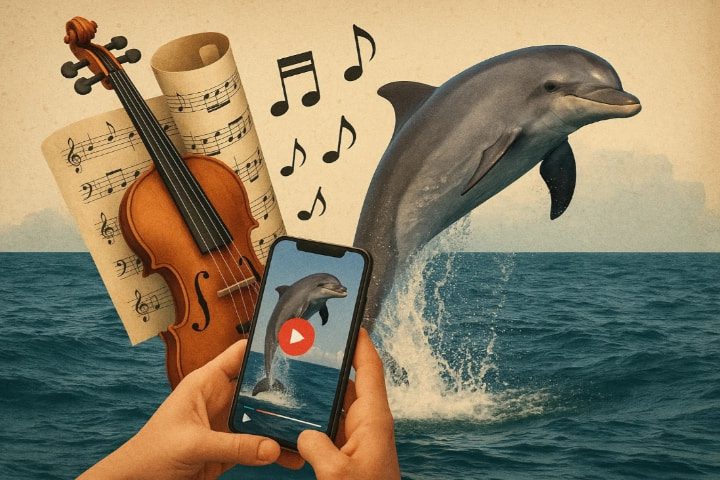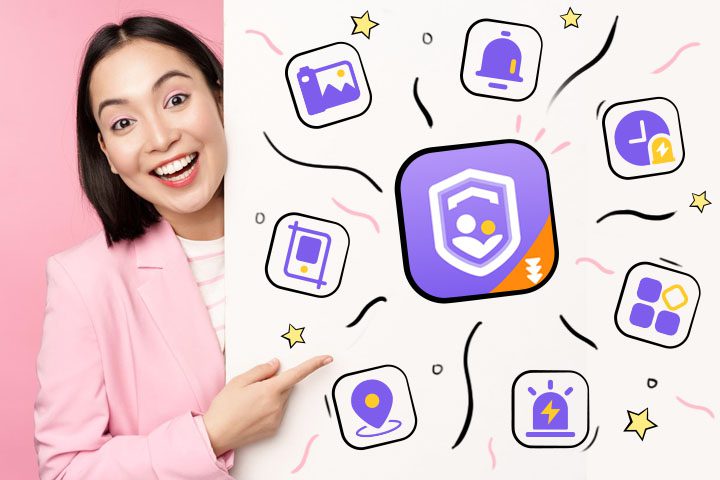Symphony Dolphin meme appears to be a comedic video featuring a dolphin alongside music and lots of laughter. Yet, as it spreads across TikTok and YouTube Shorts, countless parents find themselves wondering – is it simply mindless entertainment, or does it hold deeper concerns?
In this article, we will explore how the meme functions and what makes it appealing to teenagers. Besides that, we will review what measures guardians might take to help their kids manage social media safely. So keep learning!
What is the symphony dolphin meme?
The Symphony Dolphin meme is comprised of a comical video that features a dolphin jumping out of the water, beautifully accompanied by epic and classical music. You can most likely find it on TikTok or YouTube Shorts.



In fact, there is more to it. Other individuals tend to creatively remix this. Some prefer adding filters while including textual remarks over the video, whereas others opt for more energetic background music.
While other people use this to mock daily activities like finishing work, getting out of bed, or enduring tedious classes, you now include the dolphin as part of your storytelling.
Thus, the Symphony Dolphin meme is not only the representation of one dolphin but instead an entertaining means. It allows one to celebrate little achievements in life with friends while being extremely creative, transforming dull moments into something beyond description.
Use parental controls to protect teens from inappropriate content.
How does the symphony dolphin meme get popular among Gen Z?
The rise of the Symphony Dolphin meme was not an accident. It gained traction rapidly on the internet, especially among teenagers, and transformed into a phenomenon. What about this simple dolphin video paired with equally dramatic music warranted such profound virality?
Allow us to show you the two primary factors that contributed to its popularity.
Social media and remix culture
- First of all, dolphin videos got tremendous attention from social media because they were being shared and discussed on TikTok, Instagram Reels and YouTube shorts. All of these platforms are designed fundamentally around engagement with short 3-5 minute videos, so this is critical. As soon as one user uploaded a video using Beethoven’s Fifth where they edited in a dolphin teleporting out of water, all his followers started watching and reposting it as well.
- Remix culture: The next step was the remixing which is certain to come after any sort of viral phenomenon. This is when everything goes out of control, and other users start taking everything into their own hands with their own concepts and works.
Each one of these reels, although distinct in inspiration, had its fair share of hilarity. As a result, all templates were model thumbnails, encouraging everyone to create more of the same kind and thus drastically add to their already awesome virality.
Gen Z’s love for ironic and dramatic humour
Moreover, Gen Z’s humour focus also forms the second reason. For the most part, members of Generation Z seem to love things that are random, exaggerated, strange or weird in a purposeful way or an eccentric manner.
The Symphony Dolphin meme captures this odd style quite remarkably well. It straightforwardly takes something trivial and makes it into an oversized production; the over-the-top seriousness is what adds the laughter.
You also like expressing your emotions symbolically. With this meme, you can transform a short video into a narrative of your personal tale. As long as it reflects your feelings, you post it, and so do your friends. That exchange keeps it dynamic and evolving.
Is the symphony dolphin meme harmful or just harmless fun?
Nowadays, the Symphony Dolphin meme seems to be ubiquitous. However, out of curiosity, you might wonder if it is all lightheartedness or does it has any risks? Let’s first delve into some of the advantages, and later we can cover some of the disadvantages too.
➔ Mostly harmless
For most people, this meme is simply another instance where they can enjoy humour without any underlying issues. There is no harassment that takes place. None of the participants sustained injuries, nor did any dolphins incur injury. What makes everything ridiculously funny is the background music—It elevates routine settings into extraordinarily joyous ones.
The clip provides ample better chances. For instance, it tells how one describes their feelings while at work, after completing a small task or literally anything allows boundless potential. Thus, it serves as a safe outlet through chaotic madness-driven experimentation.
➔ Some risks, depending on use
As is the case with any meme, it all depends on how you approach it. The joke becomes deeply damaging when added to cruel commentary or Dolphin clip mockery of others. The purpose of memes should be inclusivity, not isolation.
Following every trend, such as this one, for far too long can lead to a major creativity crisis and running out of your own fun concepts. In this particular example, memes do serve a distinct purpose, and dedicated followers always have an opportunity to infuse some imagination.
So, as described in this section, such memes are largely whimsical tools used to enact play and emotion. However, like everything else on the internet, the consequences hinge on individual discretion. As long as basic courtesy is respected through its use, the meme doesn’t really cause a negative impact.
How can parents talk to teens about viral memes?
Memes have become a part of your kids’ daily lives. Most memes are intended to be funny and harmless. However, some of them can be puzzling or propagate incorrect ideas. Thus, providing a structured open dialogue creates an environment where they feel safe and supported while navigating the virtual world.
So, here I’d like to outline a few strategies that will help parents engage teens about viral memes.
1. Start with curiosity
You have to set a tone that shows interest; try to see what pops up in their heads instead of delivering a lecture. You have to try to see what springs into their minds. “What do you like about it?” Works better than most as it opens the door rather than shuts it. Not only does it soften the teenage guard, but goes a long way in making them comfortable sharing their online worlds.
2. Listen without blaming
To engage with memes constructively, you might consider asking something like, “What do you think this meme is trying to convey?” That gives your teen space to explain their take on the issue.
Keep in mind that they will be truthful with you when they know that their opinion will be permissively received. It will make the conversation turn into something positive and safe for both parents and children.
3. Talk about respect:
Moreover, you can use conversations about memes as an opportunity to remind teenagers why respect is essential. With empathy, ask them, “Would this still be funny if someone posted it about you?” Those types of questions are capable of introspecting themselves.
4. Make it a two-way conversation
In addition, seek insight from teens, such as whether it is trends or memes, because those opinions often end up being quite shocking and enlightening.
Inquire about the reasons some things appeal to them or what could be the reason behind specific memes going viral. When you show respect for his or her thoughts and opinions during conversations, your teen will realise that their ideas are respected.
Mutual awareness of digital happenings makes it easier to promote fun as well as safety and respect. Ultimately, engaging with memes does not curtail enjoyment but fosters balanced development along with concern for relevant issues that impact their lives, and interests, too. This helps in building trust, connection, and safety simultaneously.
How to keep teens safe from meme-driven risks online?
We discussed before how memes can be for simple entertainment, but they can cause confusion as well as promote dangerous fads. This is why your guidance needs to be blended with understanding.
Below are a few subtle techniques that allow soft adolescent supervision in navigating the online world freely.
Tip 1: Start off with open conversations
As a parent, you need to keep a friendly bond so that kids will share anything and everything without holding back. Hence, you may ask what some of their favourite memes are and even request an explanation behind them. Take note not to judge but respond positively to create enriching dialogues around those topics.
For instance, “Wow! That’s an interesting meme; it catches my attention and I wonder what story it tries to tell,” stands out, unlike most adult responses showing concern on kids ‘wasted time.’
Tip 2: Create rules together
Rather than imposing hard boundaries, outline mutually beneficial lines together that neither side wants to breach. Set a cap on total screen time per device/feature and permit limited access to specific apps and content only through predefined gates
Tip 3: Consider looking into parental control tools
While conversation has always worked in maintaining digital safety, as an additional protection measure, you have to look into external parental control software. Among all, FlashGet Kids has performed the best because it allows comprehensive privacy-respecting monitoring of online activities in real-time.



The tool gives reports on what programs your child engages with, as well as their active hours online and the nature of engagement with the content. In addition, it lets one assign keywords pertaining to inappropriate content. Hence, if children attempt to use such phrases while chatting, you will be notified immediately.
This is not an intrusion into privacy but rather oversight designed to provide support when danger arises. The internet is full of information, which makes supervision by parents almost imperative when it comes to managing teenagers’ time online.
Conclusion
In a nutshell, memes like the Symphony Dolphin meme encourage us to stay social and amplify the level of creativity we possess. For teenagers, especially, memes are one way of showcasing their identity without taking up too much time or needing deep thoughts.
However, we should also consider the negative effects they could have on people. This is one area in which parents’ roles come in. They have to stay involved and openly talk about the memes. With minimal guidance, one can ensure that their online enjoyment remains safe, respectful, and meaningful.
FAQs
The original source is from TikTok, where one user added dramatic music to the jumping dolphin video. In a laughable manner, people started sharing it, and then it inspired others to do their versions. That is how it went viral on different social media platforms.
Teens enjoy it because of its randomness, silliness, and accessibility of remixes and variations. The over-the-top music puts such activities into a comedic approach, which adds variety to your funny side.
While most variations are safe, there are instances when people add inappropriate or provocative captions. Thus, parents’ involvement makes online fun safer.

